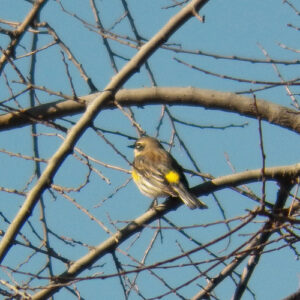- La Feria Community Holds Succesful Business Mixer Event
- Little Nashville to Take Place in Downtown Mercedes
- Lions Basketball Captures District Gold
- La Feria ISD Students Compete in Regional Chess Tournament
- Lions End First Half of 32-4A on a High Note
- La Feria ISD Held Another Successful Parent Conference
- Strong Appearance for Lions at Hidalgo Power Meet
- LFECHS Students Get to Meet Local Actress
- Students Participate in Marine Biology Camp
- Two LFECHS Students Qualify for All-State Band
Texas Songbird Migration: Don’t Put Down the Binoculars Yet
- Updated: June 7, 2013
Growing Threats in Canada’s Boreal Forest
by John Michaelson (TNS)

A yellow-rumped warbler. Photo: Robert Nunnally/TNS
AUSTIN, Texas – From their beautiful tunes to their stunning colors, songbirds still are migrating across the state and putting on their best displays this time of year. According to Steve Gross, a past president of the Texas Ornithological Society, while some may believe it’s too late for bird-watching, that’s not the case.
“We’re getting reports of 15 to 20 warbler species per day in a lot of the places along the coast,” he reported. “So a lot of people think that the migration ends about May 1st, but that’s not true. It really goes into June, and there are still plenty of birds moving through, so if you hang up your binoculars you’re missing out on a lot.”
More than 600 different species of birds have been documented in Texas, exceeding all other states in opportunities to see a wide variety of birds.
Areas along the coast are some of the best for bird-watching, said Gross, but there are many places where the viewing can be great.
“Middle of the state, though the hill country would be another, particularly the river systems that go up in kind of a northwesterly direction towards the interior of the U.S., and then you’ve got the birds that are moving through the high elevations out in the Chisos, Davis and Guadalupe Mountains out in West Texas,” he suggested.
Many of the songbirds that are at the feeders and soaring across the sky are headed to Canada’s boreal forest. The forest is remote and was largely left alone for some time, but Dr. Jeff Wells, senior scientist with the Boreal Songbird Initiative said many of the birds are at risk as the forest faces new threats.
“It is an area that is under threat from mining, forestry, oil and gas, hydro,” Wells warned. “Lots of different factors. And it is being impacted by climate change.”
About 3 billion of North America’s land birds and 26 million waterfowl breed in the boreal forest.
For more information please visit http://www.borealbirds.org/birdguide/mig_map_main.shtml.


